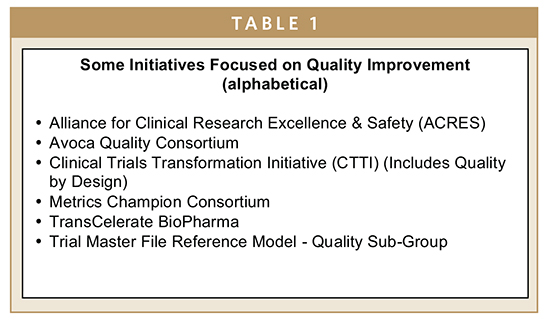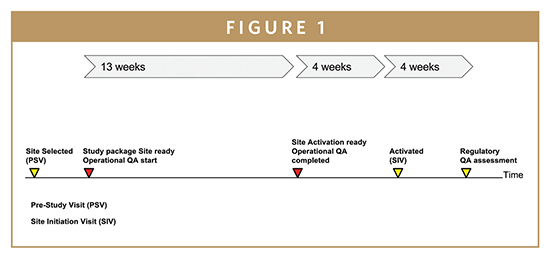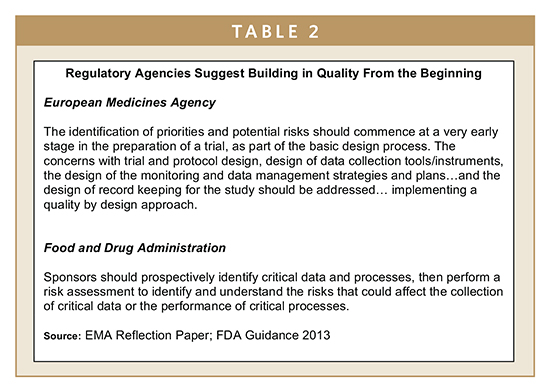Issue:January/February 2019
CLINICAL TRIALS - Spotlight on Quality in Study Startup: Automated Workflows Encourage Upfront Planning & Downstream Improvements in the eTMF
INTRODUCTION
There is a dazzling array of quality initiatives within the clinical trials sector all looking to move the needle from paper-based methods or single-point solutions to a more integrated, non-siloed approach to study conduct. These efforts (Table 1) may be rooted, at least somewhat, in work started nearly 20 years ago when the Institute of Medicine published To Err is Human, a call-to-action to improve safety in our healthcare system by linking it to greater quality.1 That seminal work was followed by various reports recognizing the urgent need to transform the clinical trials enterprise by focusing more intently on quality.2,3

Emphasis on quality is everywhere, but in particular, the study startup portion of clinical trials is a particular hotspot, as it is pivotal to improving study conduct overall. Specifically, as a complex multi-step process, it is renowned for bottlenecks that cause a seemingly intractable 8-month timeframe for moving from pre-visit through site initiation.4 Improving this bleak performance is important because study startup generates more than 40% of the artifacts that eventually flow into the trial master file (TMF).5
With unrelenting pressures to rein in budgets and cycle times, stakeholders are turning to quality as a solution, starting with building it into study startup and bringing change to the entrenched silos that stall clinical trial operations. The process starts by recognizing that many elements of clinical trial execution are rolled out during study startup, making proactive planning a priority. Without this critical step, study conduct can be delayed, siloed efforts continue, and documents eventually released to the TMF or eTMF may be missing or incomplete. Fortunately, workflow-based study startup tools are available that facilitate a proactive planning process for stakeholders seeking to improve quality by determining which documents are needed and in which format. This forward-thinking approach supports audit-readiness and greater likelihood of passing regulatory audits.
As part of proactive planning, the clinical operations team is responsible for identifying the necessary workflows, such as contract and budget agreements, and documents for the institutional review board. Once these are established, and study conduct begins, downstream functions are often handled in a tightly guarded siloed atmosphere, with each department generating its own standard operating procedures and budgets. Typical of this isolated approach is a lack of institutional knowledge of what the next department needs to fulfill its regulatory obligations and conform to performance metrics. For example, the clinical operations team may not know which documents are needed in the TMF and may be unfamiliar with the accepted format and relevant metadata. Unfortunately, these deficiencies are not detected until much later, which can harm study quality, disrupt timelines, and increase cost of operations. With a workflow-based system, however, these challenges are hammered out upfront, so problems caused by not knowing the needs of the next department are eliminated.
QUALITY STARTS EARLY
Quality is fundamental to clinical trials, but with cycle times stagnating for two decades, there is an intense focus on this subject.6 In a 2008 presentation by the Clinical Trials Transformation Initiative (CTTI), quality was defined as the ability to effectively and efficiently answer the key performance question(s) (KPQs) about the benefits and risks of a medical product or procedure while ensuring protection of human subjects.7 In answering KPQs, stakeholders are looking to industry-based metrics to measure performance. For example, one performance metric determines compliance by suggesting that regulatory quality assurance should occur 4 weeks after site activation, one of the final steps of study startup.8 But, with this timeframe, problems such as missing or incomplete documents may go unnoticed until this late date, when the study is already well underway.
A better strategy is to employ upfront workflows designed to prevent or mitigate problems associated with document completion. As shown in Figure 1, the 4-week post-activation quality assurance timeframe plus the 17 weeks needed for development of the study package through to study activation yields a lengthy 21 weeks. Instead, if the workflow process starts from the beginning of the clinical trial — with developing the study package — artifacts and documents are developed 17 weeks earlier, well before study activation, problem detection can occur months sooner.9 This is a major improvement that helps ensure the quality of TMF artifacts and associated metadata downstream and enables audit readiness.

To better educate stakeholders about the critical importance of early commitment to quality in clinical trials, the Metrics Champion Consortium (MCC) has launched the MCC Study Quality Trailblazer Team.10 This team seeks to help its members set an example for the rest of the industry by demonstrating that investing time and resources upfront can yield higher quality clinical study performance at a lower cost than attempting to fix quality issues later on, after the study is underway. The Trailblazers aim to achieve this by implementing changes that:
-Do a better job of identifying and reducing risks before the start of a study
-Produce high-quality protocols
-Oversee risks during the study
They have also released a white paper, which uses data from the Tufts Center for the Study of Drug Development (CSDD) to document that study quality is actually declining despite major advancements in technology over the past 20 years, often due to issues that are preventable.11
Reversing this trend means building in quality from the start, and significantly, this approach aligns with regulatory initiatives to upgrade study quality. One of the most widely anticipated was the November 2016 release of the first new Good Clinical Practice guideline (GCP) in 20 years.12 Put forth by the International Conference on Harmonisation (ICH), the guideline, known as ICH-GCP E6(R2), includes Section 5.0, which defines Quality Management. It states that the sponsor should implement a system to manage quality throughout all stages of the trial process. This section addresses topics such as critical process and data identification followed by sub-sections dedicated to risk factors, namely risk identification, risk evaluation, and more. Furthermore, the sponsor is to ensure that operational documents such as the protocol, case report forms, and others are to be concise and consistent, and all aspects of the trial are operationally feasible.
The ICH-GCP E6(R2) guideline follows on the heels of regulatory documents released by the European Medicines Agency (EMA) and the Food and Drug Administration (FDA) in 2013, citing that risk-based quality management should start prospectively, meaning early on, as clinical trials are preparing for launch (Table 2).13,14 The new ICH-GCP guideline builds on this foundation.

BREAKING DOWN SILOS
In the ongoing discussion of factors contributing to poor quality in clinical trials, the EMA Reflection Paper cites fragmentation of all sorts — lack of clear distribution of roles among players, piecemeal implementation of technology, unconnected standardized solutions — as causes of quality issues. This insight reflects the siloed approach that has long typified clinical trial operations and continues to do so. It is often casually referred to as the “throw it over the wall” mentality, meaning that once a specific department has completed its work, it is tossed over the wall to the next department, with little understanding of what is needed downstream.15
This awkward management style is one of the root causes of problems with the TMF and eTMF. Specifically, information about the standardized taxonomy and metadata provided in the TMF Reference Model is not shared with clinical operations team members, so they are often unaware of the documents needed or the required format for release into the TMF. Later on, this is problematic for the regulatory group tasked with mapping documents to the TMF, as well as indexing the metadata, as startup generates nearly half of the TMF artifacts.5
There is a growing body of literature detailing how breaking down silos is pivotal to better study execution. A recent article by Melissa Fassbender notes clinical trial technology has evolved to the point that forward-thinking companies will soon distinguish themselves by moving away from vertical silos and embracing “thinking horizontally.” This refers to using automation and workflows to integrate operational data across all functions.16 And using this approach, it will be easier to extract meaningful insights from those data and answer KPQs. Similarly, other articles are promoting the importance of eliminating silos in favor of a cross-functional, horizontal method for critical operations such as contracts and budgeting, and governance.17,18 Strategy &, PwC’s strategy consulting group, published a lengthy report on the cross-functional team method as key to revamping the siloed business model that is all too common in the pharmaceutical sector.19 They note that interdependent functions should be brought together through critical teams and through the use of technology to better navigate today’s complicated regulatory maze. And while cross-functional teams are not a panacea, they are an important first step in moving away from the traditional “over-the-wall” mentality.
QUALITY THROUGH WORKFLOWS
Optimizing study conduct starts with embracing a workflow-based approach to defining the documents needed for the multi-step study startup process. This method boosts the quality of study conduct by preparing documents that are accurate, complete, and conform to the eTMF format established by a sponsor’s or contract research organization’s (CRO) regulatory team, enhancing audit readiness.
Study startup workflow-based solutions facilitate quality efforts by integrating data flow from several eClinical solutions, such as electronic data capture, the clinical trial management system and eTMF, ensuring an end-to-end continuum that allows properly formatted documents and structured artifacts to flow into the eTMF.
With the help of workflows, any and all documents eventually needed for the TMF or eTMF can be defined. This is a major advantage because typically there are more than 400 draft and supporting artifacts that can be structured using a workflow-based tool, resulting in a final set of approximated 60 artifacts that will ultimately be released into the eTMF. One example is the completed clinical trial agreement, which is composed of numerous sub-artifacts, as shown in Figure 2.

FOR QUALITY, PLAN & BREAK DOWN SILOS
Across the industry, proactive planning for improved clinical trial quality is in early stages, but with the availability of workflow-based tools starting from study startup, process changes are taking root. These changes look to be transformational as the documents, artifacts, and associated metadata needed for the eTMF can be planned upfront. Using this approach, entrenched silos will no longer be obstacles to the downstream regulatory team receiving accurate and correctly formatted documents from previous groups in what has often been a long and inefficient chain of study execution. In its place is a more efficient process that streamlines data collection in the format needed by the regulatory group to map the information in the eTMF.
By implementing this approach, stakeholders enjoy the benefits of being audit ready, information will be more easily retrievable, and there is a greater likelihood of adherence to cycle times and budgets. And critically, issues will be identified early on, rather than waiting until they reach the eTMF. As the industry turns its attention to quality improvement, these positive outcomes will encourage widespread acceptance of this strategy.
REFERENCES
- Committee on Quality of Health Care in America. To err is human. Building a safer health system. Institute of Medicine. 1999. Available at: http://www.nationalacademies.org/hmd/~/media/Files/Report_Files/1999/To-Err-isHuman/To_Err_is_Human_1999__report_brief.pdf. Accessed May 4, 2017.
- Weisfeld N, English RA, Claiborne AB. Envisioning a transformed clinical trials enterprise in the United States: Establishing an agenda for 2020: Workshop Summary. Institute of Medicine. 2012. Available at: http://www.fdanews.com/ext/resources/files/archives/4/4-17-12-trials.pdf. Accessed May 4, 2017.
- Kramer JM, Schulman KA. Transforming the economics of clinical trials. Institute of Medicine. 2012.
- Getz K. Uncovering the drivers of R&D costs. Proprietary presentation 2015, citing data from the Tufts Center for the Study of Drug Development.
- Trial Master File Reference Model. Available at: https://tmfrefmodel.com/2015/06/16/version-3-released/. Accessed May 4, 2017.
- Getz K. Assessing and addressing site identification and activation inefficiencies. Tufts Center for the Study of Drug Development. March 2016.
- Definition from October 2008 presentation on CTTI by Dr. Rachel Behrman, CTTI Co-chair and then Associate Commissioner for Clinical Programs, FDA. Available at: https://www.fda.gov/downloads/drugs/developmentapprovalprocess/smallbusinessassistance/ucm303954.pdf. Accessed May 9, 2017.
- Metrics Champion Consortium. TMF Metric Initiative. 2017.
- Study startup around the world: A preliminary view from goBalto. ChromoReport. March 2017. Available at: https://www.gobalto.com/chromoreport-mar2017. Accessed May 10, 2017.
- MCC Risk and Quality Management Support Group. MCC Study Quality Trailblazer Team. 2016. Available at: http://metricschampion.org/trailblazer-team/. Accessed May 10, 2017.
- MCC Risk and Quality Management Support Group. MCC Study Quality Trailblazer Team. 2016. Available at: http://metricschampion.org/trailblazer-team/. Accessed May 10, 2017.
- Integrated addendum to ICH E6(R1): guideline for Good Clinical Practice E6(R2). ICH Harmonised Guideline. 2016. Available at: http://www.ich.org/fileadmin/Public_Web_Site/ICH_Products/Guidelines/Efficacy/E6/E6_R2__Step_4.pdf. Accessed May 10, 2017.
- European Medicines Agency. Reflection Paper on risk based quality management in clinical trials. November 2013. Available at: http://www.ema.europa.eu/docs/en_GB/document_library/Scientific_guideline/2013/11/WC500155491.pdf. Accessed May 11, 2017.
- Guidance for Industry: Oversight of clinical investigations — A risk-based approach to monitoring. Food and Drug Administration. August 2013. Available at: http://www.fda.gov/downloads/Drugs/GuidanceComplianceRegulatoryInformation/Guidances/UCM269919.pdf. Accessed May 11, 2017.
- Doyle J, DeBard D, Butcher A, et al. Partnerships 2010: Let’s Make a Deal: Breaking out of organizational silos – Bridging the gap from clinical development to commercialization. KNECT 365 Clinical Trials. Available at: http://www.clinicaltrialpartnershipsblog.com/2010/04/partnerships-2010-lets-makedeal. html?m=1. Accessed May 16, 2017.
- Fassbender M. The rise of ‘technology-enabled’ clinical research companies. Outsourcing-pharma.com. January 2017. Available at: http://www.outsourcingpharma.com/Clinical-Development/The-rise-of-technology-enabledclinical-research-companies. Accessed May 11, 2017.
- Lane M. Eliminating Silos: Embracing Customer Centricity in Drug Development. Pharmaceutical Compliance Monitor. December 2015. Available at: http://www.pharmacompliancemonitor.com/eliminating-silos-embracing-customer-centricity-in-drug-development/10111/. Accessed May 11, 2017.
- Garguilo L. Breaking down silos in the field of pharma. Outsourced Pharma. 2015. Available at: https://www.outsourcedpharma.com/doc/breaking-down-silos-in-thefield-of-pharma-0001. Accessed May 10, 2017.
- Pisani J, Lee M. A critical makeover for pharmaceutical companies. Overcoming industry obstacles with a cross-functional strategy. Strategy & PwC. 2016. Available at: https://www.strategyand.pwc.com/reports/critical-makeover-pharmaceutical-companies. Accessed May 12, 2017.
To view this issue and all back issues online, please visit www.drug-dev.com.

Elvin Thalund is the Director, Industry Strategy at Oracle Health Sciences. He is a recognized industry expert in clinical trials, having over 20 years of experience working as a Clinical Business Analyst Consultant at major pharmaceutical companies, including Hoffmann-La Roche and Johnson & Johnson. He is the co-chair on the TMF Reference Model Exchange Mechanism and earned his Master of Science in Industrial Engineering from Aalborg Universitet.

Craig Morgan is the Head of Marketing, Study Start Up at Oracle Health Sciences. He is a technology and life sciences management professional with more than 15 years of experience in the application of informatics and bioinformatics to drug discovery. His passion is transforming study management and trial execution processes, which are supported by facilitating systems, to allow sponsors, CROs, and sites to reduce cycle times and improve collaboration and oversight in clinical trials.
Total Page Views: 6346










